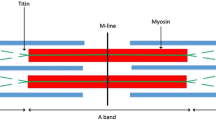Epidural and electromagnetic stimulation of the cervical and lumbar parts of the spinal cord at a frequency of 5 Hz was found to induce locomotor activity in decerebrate cats on a moving treadmill belt. Differences were found in the initiation of locomotion using different means and locations of stimulation. Stimulation at a frequency of 0.3 Hz induced single reflex responses in the muscles of the fore- and hindlimbs. Analysis of the structure of reflex responses showed that locomotor ability depends on the level of involvement and activity of polysynaptic reflex pathways. The hypothesis that that stepping generators are activated indirectly via activation of the dorsal roots during epidural stimulation and by more direct activation of the neural locomotor network during electromagnetic stimulation of the spinal cord is discussed.
Similar content being viewed by others
References
V. D. Avelev, R. Matur, D. Bikhard, et al., “Initiation of locomotion in decerebrate cats by pulsed magnetic fields projected onto spinal cord segments,” Ros. Fiziol. Zh., Vol. 95, No. 11, 1216–1224 (2009).
I. N. Bogacheva, V. I. Kucher, N. A. Shcherbakova, et al., “Mathematical modeling of the processes forming locomotor patterns in epidural stimulation of the spinal cord with consideration of peripheral feedback,” Biofizika, 50, No. 6, 1125–1131 (2005).
Yu. P. Gerasimenko, I. A. Lavrov, I. N. Bogacheva, et al., “Characteristics of the formation of locomotor patterns in decerebrate cats in epidural stimulation of the spinal cord,” Ros. Fiziol. Zh., 89, No. 9, 1046–1057 (2003).
R. M. Gorodnichev, E. M. Machueva, E. A. Pivovarova, et al., “A new means of activating stepping movement generators in humans,” Fiziol. Chel., 36, No. 6, 95–103 (2010).
P. E. Musienko, I. N. Bogacheva, and Yu. P. Gerasimenko, “Significance of peripheral feedback in generating stepping movements in epidural stimulation of the spinal cord,” Ros. Fiziol. Zh., 95, No. 12, 1407–1420 (2005).
P. E. Musienko, N. V. Baranova, V. A. Selionov, and Yu. P. Gerasimenko, “Locomotion induced by epidural stimulation in decerebrate cats after spinal cord injury,” Biofizika, 54, No. 2, 293–300 (2009).
M. L. Shik, “The locomotor area of the brainstem and the ‘locomotor column’ hypothesis,” Usp. Fiziol. Nauk., 16, 76–95 (1985).
B. Coburn, “Electrical stimulation of the spinal cord: two-dimensional finite element analysis with particular reference to epidural electrodes,” Med. Biol. Eng. Comput., 18, 573–584 (1980).
B. Coburn, “A theoretical study of epidural electrical stimulation of the spinal cord. Part II. Effects on long myelinated fibers,” IEEE Trans. Biomed. Eng., 32, 978–986 (1985).
B. Coburn and W. K. Sin, “A theoretical study of epidural electrical stimulation of the spinal cord. Part I: finite element analysis of stimulus fields,” IEEE Trans. Biomed. Eng., 32, 971–977 (1985).
M. Dmitrijevic, Yu. K. Gerasimenko, and M. Pinter, “Evidence for a spinal central pattern generator in humans,” Ann. N.Y. Acad. Sci., 16, 360–376 (1998)
Y. P. Gerasimenko, R. R. Roy, and V. R. Edgerton, “Epidural stimulus: comparison of the spinal circuits that generate and control locomotion in rats, cats and humans,” Exp. Neurol., 209, 417–425 (2008).
Y. Gerasimenko, R. Gorodnichev, E. Machueva, et al., “Novel and direct access to the human locomotor spinal circuitry,” J. Neurosci., 30, No. 10, 3700–3708 (2010).
S. Grillner and P. Zangger, “On the central generation of locomotion in the low spinal cat,” Exp. Brain Res., 34, 241–261 (1979).
L. Gurfinkel, Y. S. Levik, O. V. Kazennikov, and V. A. Selionov, “Locomotor-like movements evoked by leg muscle vibrations in humans,” Eur. J. Neurosci., 10, 1608–1612 (1998).
A. L. Hodgkin and A. F. Huxley, “A quantitative description of membrane current and its application to conduction and excitation in nerve,” J. Physiol. (London), 117, 500–544 (1952).
J. Holsheimer, “Computer modelling of spinal cord stimulation and its contribution to therapeutic efficacy,” Spinal Cord, 36, 531–540 (1998).
A. S. Hunanyan, H. A. Petrosyan, V. Alessi, and V. L. Arvanian, “Repetitive spinal electromagnetic stimulation opens a window of synaptic plasticity in damaged spinal cord: role of NMDA receptors,” J. Neurophysiol., 107, No. 11, 3027–3039 (2012).
R. M. Ichiyama, Yu. P. Gerasimenko, H. Zhong, et al., “Hindlimb stepping movements in complete spinal rats induced by epidural spinal cord stimulation,” Neurosci. Lett., 338, 339–344 (2005).
I. Lavrov, Y. P. Gerasimenko, R. M. Ichiyama, et al., “Plasticity of spinal cord reflexes after complete transection in adult rats: relation to stepping ability,” J. Neurophysiol., 96, 1699–1710 (2006).
J. Malmivuo and R. Plonsey, Bioelectromagnetism, Oxford University Press, New York, Oxford (1995).
K. Minassian, B. Jilge, F. Rattay, et al., “Stepping-like movements in humans with complete spinal cord injury induced by epidural stimulation of the lumbar cord: electromyographical study of compound muscle action potentials,” Spinal Cord, 42, 401–416 (2004).
V. K. Mushahwar, D. M. Gillard, M. J. Gauthier, and A. Prochazka, “Intraspinal micro stimulation generates locomotor-like and feedback controlled movements,” IEEE Trans. Neural Syst. Rehabil. Eng., 10, 68–81 (2002).
G. N. Orlovsky, T. G. Deliagina, and S. Grillner, Neuronal Control of Locomotion. From Mollusk to Man, Oxford University Press, Oxford (1999).
S. Rossignol, C. Chau, E. Brustein, et al., “Pharmacological activation and modulation of the central pattern generator for locomotion in the cat,” Ann. N.Y. Acad. Sci., 860, 346–359 (1998)
M. N. Sadiku, Elements of Electromagnetics, Oxford University Press, Oxford (2007).
V. A. Selionov, Y. P. Ivanenko, I. A. Solopova, and V. S. Gurfinkel, “Tonic central and sensory stimuli facilitate involuntary air-stepping in humans,” J. Neurophysiol., 101, 2847 (2009).
Author information
Authors and Affiliations
Corresponding author
Additional information
Translated from Rossiiskii Fiziologicheskii Zhurnal imeni I. M. Sechenova, Vol. 98, No. 9, pp. 1079–1093, September, 2012.
Rights and permissions
About this article
Cite this article
Bogacheva, I.N., Musienko, P.E., Shcherbakova, N.A. et al. Analysis of Locomotor Activity in Decerebrate Cats Using Electromagnetic and Epidural Electrical Stimulation of the Spinal Cord. Neurosci Behav Physi 44, 552–559 (2014). https://doi.org/10.1007/s11055-014-9950-1
Received:
Published:
Issue Date:
DOI: https://doi.org/10.1007/s11055-014-9950-1




